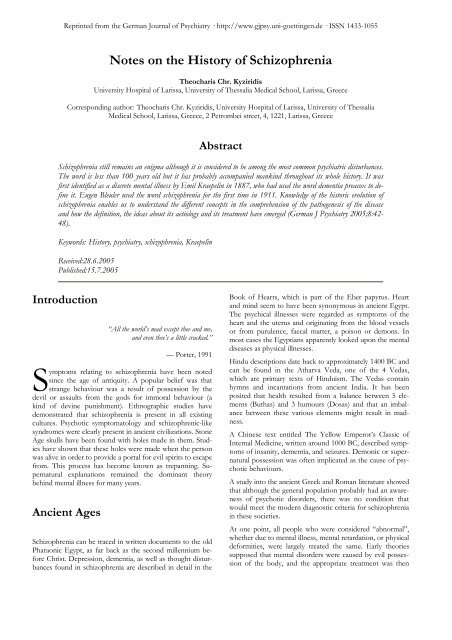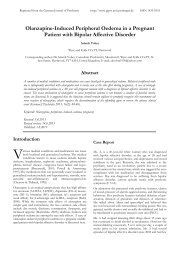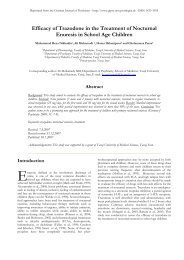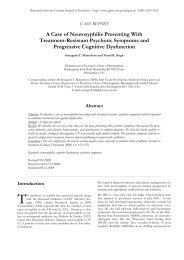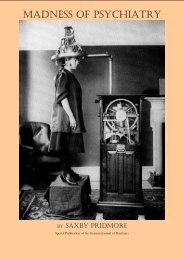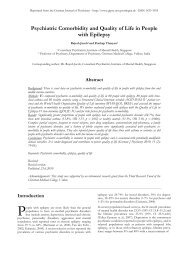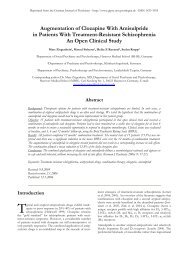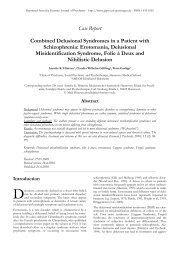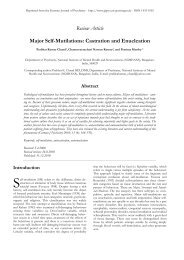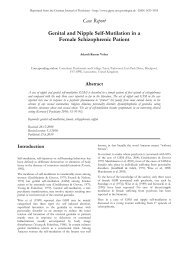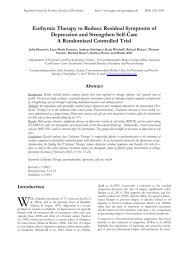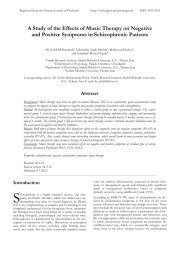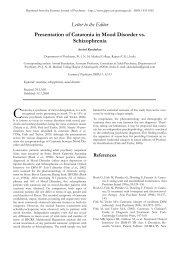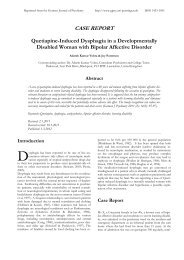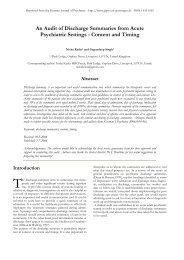Notes on the History of Schizophrenia - German journal of psychiatry
Notes on the History of Schizophrenia - German journal of psychiatry
Notes on the History of Schizophrenia - German journal of psychiatry
Create successful ePaper yourself
Turn your PDF publications into a flip-book with our unique Google optimized e-Paper software.
Reprinted from <strong>the</strong> <strong>German</strong> Journal <strong>of</strong> Psychiatry · http://www.gjpsy.uni-goettingen.de · ISSN 1433-1055<br />
<str<strong>on</strong>g>Notes</str<strong>on</strong>g> <strong>on</strong> <strong>the</strong> <strong>History</strong> <strong>of</strong> <strong>Schizophrenia</strong><br />
Theocharis Chr. Kyziridis<br />
University Hospital <strong>of</strong> Larissa, University <strong>of</strong> Thessalia Medical School, Larissa, Greece<br />
Corresp<strong>on</strong>ding author: Theocharis Chr. Kyziridis, University Hospital <strong>of</strong> Larissa, University <strong>of</strong> Thessalia<br />
Medical School, Larissa, Greece, 2 Petrombei street, 4, 1221, Larissa, Greece<br />
Abstract<br />
<strong>Schizophrenia</strong> still remains an enigma although it is c<strong>on</strong>sidered to be am<strong>on</strong>g <strong>the</strong> most comm<strong>on</strong> psychiatric disturbances.<br />
The word is less than 100 years old but it has probably accompanied mankind throughout its whole history. It was<br />
first identified as a discrete mental illness by Emil Kraepelin in 1887, who had used <strong>the</strong> word dementia preacox to define<br />
it. Eugen Bleuler used <strong>the</strong> word schizophrenia for <strong>the</strong> first time in 1911. Knowledge <strong>of</strong> <strong>the</strong> historic evoluti<strong>on</strong> <strong>of</strong><br />
schizophrenia enables us to understand <strong>the</strong> different c<strong>on</strong>cepts in <strong>the</strong> comprehensi<strong>on</strong> <strong>of</strong> <strong>the</strong> pathogenesis <strong>of</strong> <strong>the</strong> disease<br />
and how <strong>the</strong> definiti<strong>on</strong>, <strong>the</strong> ideas about its aetiology and its treatment have emerged (<strong>German</strong> J Psychiatry 2005;8:42-<br />
48).<br />
Keywords: <strong>History</strong>, <strong>psychiatry</strong>, schizophrenia, Kraepelin<br />
Received:28.6.2005<br />
Published:15.7.2005<br />
Introducti<strong>on</strong><br />
“All <strong>the</strong> world’s mad except <strong>the</strong>e and me,<br />
and even <strong>the</strong>e’s a little cracked.”<br />
— Porter, 1991<br />
S<br />
ymptoms relating to schizophrenia have been noted<br />
since <strong>the</strong> age <strong>of</strong> antiquity. A popular belief was that<br />
strange behaviour was a result <strong>of</strong> possessi<strong>on</strong> by <strong>the</strong><br />
devil or assaults from <strong>the</strong> gods for immoral behaviour (a<br />
kind <strong>of</strong> devine punishment). Ethnographic studies have<br />
dem<strong>on</strong>strated that schizophrenia is present in all existing<br />
cultures. Psychotic symptomatology and schizophrenic-like<br />
syndromes were clearly present in ancient civilizati<strong>on</strong>s. St<strong>on</strong>e<br />
Age skulls have been found with holes made in <strong>the</strong>m. Studies<br />
have shown that <strong>the</strong>se holes were made when <strong>the</strong> pers<strong>on</strong><br />
was alive in order to provide a portal for evil spirits to escape<br />
from. This process has become known as trepanning. Supernatural<br />
explanati<strong>on</strong>s remained <strong>the</strong> dominant <strong>the</strong>ory<br />
behind mental illness for many years.<br />
Ancient Ages<br />
<strong>Schizophrenia</strong> can be traced in written documents to <strong>the</strong> old<br />
Phara<strong>on</strong>ic Egypt, as far back as <strong>the</strong> sec<strong>on</strong>d millennium before<br />
Christ. Depressi<strong>on</strong>, dementia, as well as thought disturbances<br />
found in schizophrenia are described in detail in <strong>the</strong><br />
Book <strong>of</strong> Hearts, which is part <strong>of</strong> <strong>the</strong> Eber papyrus. Heart<br />
and mind seem to have been syn<strong>on</strong>ymous in ancient Egypt.<br />
The psychical illnesses were regarded as symptoms <strong>of</strong> <strong>the</strong><br />
heart and <strong>the</strong> uterus and originating from <strong>the</strong> blood vessels<br />
or from purulence, faecal matter, a pois<strong>on</strong> or dem<strong>on</strong>s. In<br />
most cases <strong>the</strong> Egyptians apparently looked up<strong>on</strong> <strong>the</strong> mental<br />
diseases as physical illnesses.<br />
Hindu descripti<strong>on</strong>s date back to approximately 1400 BC and<br />
can be found in <strong>the</strong> Atharva Veda, <strong>on</strong>e <strong>of</strong> <strong>the</strong> 4 Vedas,<br />
which are primary texts <strong>of</strong> Hinduism. The Vedas c<strong>on</strong>tain<br />
hymns and incantati<strong>on</strong>s from ancient India. It has been<br />
posited that health resulted from a balance between 5 elements<br />
(Buthas) and 3 humours (Dosas) and that an imbalance<br />
between <strong>the</strong>se various elements might result in madness.<br />
A Chinese text entitled The Yellow Emperor’s Classic <strong>of</strong><br />
Internal Medicine, written around 1000 BC, described symptoms<br />
<strong>of</strong> insanity, dementia, and seizures. Dem<strong>on</strong>ic or supernatural<br />
possessi<strong>on</strong> was <strong>of</strong>ten implicated as <strong>the</strong> cause <strong>of</strong> psychotic<br />
behaviours.<br />
A study into <strong>the</strong> ancient Greek and Roman literature showed<br />
that although <strong>the</strong> general populati<strong>on</strong> probably had an awareness<br />
<strong>of</strong> psychotic disorders, <strong>the</strong>re was no c<strong>on</strong>diti<strong>on</strong> that<br />
would meet <strong>the</strong> modern diagnostic criteria for schizophrenia<br />
in <strong>the</strong>se societies.<br />
At <strong>on</strong>e point, all people who were c<strong>on</strong>sidered “abnormal”,<br />
whe<strong>the</strong>r due to mental illness, mental retardati<strong>on</strong>, or physical<br />
deformities, were largely treated <strong>the</strong> same. Early <strong>the</strong>ories<br />
supposed that mental disorders were caused by evil possessi<strong>on</strong><br />
<strong>of</strong> <strong>the</strong> body, and <strong>the</strong> appropriate treatment was <strong>the</strong>n
HISTORY OF SCHIZOPHRENIA<br />
exorcising <strong>the</strong>se dem<strong>on</strong>s, through various means, ranging<br />
from innocuous treatments, such as exposing <strong>the</strong> patient to<br />
certain types <strong>of</strong> music, to dangerous and sometimes deadly<br />
means, such as releasing <strong>the</strong> evil spirits by drilling holes in<br />
<strong>the</strong> patient’s skull.<br />
The ancient Greeks took a great interest in <strong>the</strong> human psyche<br />
and especially in madness. Plato who lived in <strong>the</strong> 5th and<br />
4th centuries BC speaks about two kinds <strong>of</strong> madness, <strong>on</strong>e<br />
with a divine origin and ano<strong>the</strong>r with a physical origin. The<br />
divine madness may create prophets, relieve <strong>the</strong> generati<strong>on</strong><br />
<strong>of</strong> impurity, inspire poets, or provoke an intense desire for<br />
beauty, according to Plato. The idea <strong>of</strong> <strong>the</strong> divine madness<br />
was firmly rooted in <strong>the</strong> Greek culture even before Plato. It<br />
also appears in <strong>the</strong> Greek tragedies, for instance in Heracles<br />
by Euripides, from <strong>the</strong> 5th century BC. But in that tragedy<br />
madness ends in catastrophe.<br />
In <strong>the</strong> Dialogues Plato wrote that “...to think about curing<br />
<strong>the</strong> head al<strong>on</strong>e, and not <strong>the</strong> rest <strong>of</strong> <strong>the</strong> body also, is <strong>the</strong><br />
height <strong>of</strong> folly... . And <strong>the</strong>refore if <strong>the</strong> head and body are to<br />
be well, you must begin by curing <strong>the</strong> soul.” He advanced<br />
<strong>the</strong> idea <strong>of</strong> unc<strong>on</strong>scious and illogical mental processes, suggesting<br />
that all people had a capacity for irrati<strong>on</strong>al thinking.<br />
He also speculated that “...when <strong>the</strong> rest <strong>of</strong> <strong>the</strong> soul – which<br />
is rati<strong>on</strong>al, mild and its governing – is asleep, and when that<br />
part which is savage and rude, being satisfied with food and<br />
drink, frisks about, drives away sleep, and seeks to go and<br />
accomplish its practice... that in every <strong>on</strong>e resides a certain<br />
species <strong>of</strong> desires that are terrible, savage, and irregular, even<br />
in some that we deem ever so moderate...”.<br />
The plat<strong>on</strong>ic ideas <strong>of</strong> a c<strong>on</strong>necti<strong>on</strong> between madness and<br />
prophecy recur in <strong>the</strong> ancient Israel. The highly esteemed<br />
religious prophets were <strong>of</strong>ten regarded as mad because <strong>of</strong><br />
<strong>the</strong>ir odd utterances and deviant clo<strong>the</strong>s and Behavior. The<br />
same c<strong>on</strong>cepti<strong>on</strong>s later appear in <strong>the</strong> Koran in <strong>the</strong> Islamic<br />
countries. Even if <strong>the</strong> Muslim nursing ward sometimes used<br />
brutal procedures <strong>the</strong> Orthodox Islam did not give as much<br />
support to exorcism as Christianity did, and surely not as an<br />
alternative to medical treatment. The word Majnun is <strong>the</strong><br />
Muslim word for mad or possessed while a jinn is a supernatural<br />
spirit. According to Koran a jinn may lie behind a<br />
mental illness.<br />
Even in Greece <strong>the</strong> relati<strong>on</strong> between madness and genius<br />
survived. The written collecti<strong>on</strong> Problemata is usually attributed<br />
to Aristotle who lived in <strong>the</strong> 4th century BC. One <strong>of</strong><br />
<strong>the</strong> written documents begins with <strong>the</strong> questi<strong>on</strong> “How come<br />
that all men distinguished in philosophy, statesmanship,<br />
poetry or art are melancholics and some <strong>of</strong> <strong>the</strong>m to such an<br />
extent that <strong>the</strong>y are affected by <strong>the</strong> illnesses originating from<br />
<strong>the</strong> black bile (melaines choles), <strong>of</strong> which <strong>the</strong> story <strong>of</strong> Heracles<br />
tells us?”. The author himself answers that <strong>the</strong> black bile<br />
may influence mood and behaviour by am<strong>on</strong>g o<strong>the</strong>r things<br />
cold and heat. In favourable circumstances this may lead to<br />
great achievements, while o<strong>the</strong>rwise <strong>the</strong> result may be madness.<br />
But c<strong>on</strong>trary to Plato <strong>the</strong> author does not believe in any<br />
madness <strong>of</strong> a divine origin.<br />
The influence from Hippocrates is obvious in <strong>the</strong> citati<strong>on</strong><br />
from Problemata. Hippocrates, <strong>the</strong> “fa<strong>the</strong>r <strong>of</strong> medicine“, was<br />
partly a c<strong>on</strong>temporary with Plato. He has given rise to <strong>the</strong><br />
Hippocratic Collecti<strong>on</strong>. In <strong>on</strong>e <strong>of</strong> <strong>the</strong> documents, “The Holy<br />
Disease“, <strong>the</strong> author objects to <strong>the</strong> opini<strong>on</strong> that illnesses like<br />
epilepsy, madness and c<strong>on</strong>fusi<strong>on</strong> are caused by <strong>the</strong> gods.<br />
Instead he argues that „...<strong>on</strong>ly from <strong>the</strong> brain spring our<br />
pleasures, our feelings <strong>of</strong> happiness, laughter and jokes, our<br />
pain, our sorrows and tears.... This same organ makes us<br />
mad or c<strong>on</strong>fused, inspires us with fear and anxiety...“. Then<br />
<strong>the</strong> author describes <strong>the</strong> famous humoural pathology, a<br />
model to explain <strong>the</strong> origin <strong>of</strong> <strong>the</strong> diseases as a disturbance<br />
<strong>of</strong> <strong>the</strong> balance <strong>of</strong> <strong>the</strong> humours that is <strong>the</strong> body fluids. This<br />
model groups <strong>the</strong> humours into blood, phledge, yellow bile<br />
and black bile. According to <strong>the</strong> humoural pathology an<br />
imbalance <strong>of</strong> <strong>the</strong> body fluids may influence <strong>the</strong> brain and<br />
provoke madness. The disturbance is caused by a complex<br />
co-operati<strong>on</strong> between <strong>the</strong> outer envir<strong>on</strong>ment and interior<br />
physical factors, including inheritance. The humours are<br />
coupled to <strong>the</strong> four elements <strong>of</strong> air, water, fire and earth.<br />
The blood is warm and wet like <strong>the</strong> air, <strong>the</strong> phledge is wet<br />
and cold like water, <strong>the</strong> yellow bile is hot and dry like fire,<br />
and <strong>the</strong> black bile is dry and cold like earth. Moreover, <strong>the</strong><br />
ages <strong>of</strong> man and <strong>the</strong> changes <strong>of</strong> <strong>the</strong> seas<strong>on</strong>s play a role. Diseases<br />
are cured through correcting <strong>the</strong> imbalance with <strong>the</strong><br />
help <strong>of</strong> diet or lifestyle. For instance, if an illness is caused by<br />
too little blood <strong>the</strong> body shall be provided with wet and heat.<br />
Later <strong>the</strong> four humours were also related with temperament.<br />
Blood is c<strong>on</strong>nected with sanguine, phledge with phlegmatic,<br />
yellow bile with choleric and black bile with melancholic<br />
temperament. Different methods <strong>of</strong> emptying <strong>the</strong> body <strong>of</strong><br />
fluids were also added, such as blood-letting, purgatives,<br />
vomiting and purulence.<br />
Hippocrates wanted to build his <strong>the</strong>ories <strong>on</strong> a rati<strong>on</strong>alistic<br />
and empirical basis. In that he c<strong>on</strong>tinued <strong>the</strong> traditi<strong>on</strong> <strong>of</strong> <strong>the</strong><br />
i<strong>on</strong>ic Greek philosophers who wanted to explain nature in a<br />
rati<strong>on</strong>al way. Hippocratic medicine draws a sharp line between<br />
knowledge and belief. It clearly criticizes <strong>the</strong> methods<br />
<strong>of</strong> magicians and quacks even in <strong>the</strong> treatment <strong>of</strong> mental<br />
diseases, which are c<strong>on</strong>sidered to be biologically rooted.<br />
However, no <strong>of</strong>ficial view existed <strong>on</strong> <strong>the</strong> origin <strong>of</strong> diseases in<br />
antiquity, and <strong>the</strong>re were <strong>of</strong>ten o<strong>the</strong>r opini<strong>on</strong>s am<strong>on</strong>g <strong>the</strong><br />
laymen than am<strong>on</strong>g <strong>the</strong> academics. The belief that mentally<br />
ill pers<strong>on</strong>s were possessed by devils was widely spread. Humoural<br />
pathology competed with astrology, magic and occultism,<br />
which played an important role in <strong>the</strong> popular traditi<strong>on</strong>.<br />
Apart from <strong>the</strong> academically educated physicians <strong>the</strong>re<br />
were a lot <strong>of</strong> o<strong>the</strong>r pers<strong>on</strong>s, for instance priests, who tried to<br />
cure <strong>the</strong> ill with an arsenal <strong>of</strong> different <strong>the</strong>rapies, such as<br />
medical herbs, gymnastics, magic and exorcism. In <strong>the</strong> holy<br />
temples academic treatments were mixed with religious rites.<br />
The origins <strong>of</strong> many enlightened treatments may be found in<br />
<strong>the</strong> Greek and Roman period. Asclepiades advocated <strong>the</strong> use<br />
<strong>of</strong> music and invented a swinging bed designed to relax <strong>the</strong><br />
agitated patient. He regarded mental disorders as stemming<br />
from emoti<strong>on</strong>al disturbances (passi<strong>on</strong>s <strong>of</strong> sensati<strong>on</strong>). Cicero<br />
rejected <strong>the</strong> Hippocratic bile <strong>the</strong>ory stating that emoti<strong>on</strong>al<br />
factors could cause physical illness. He believed that man<br />
could help with his own cure through philosophy. Soranus,<br />
in <strong>the</strong> 2nd century, suggested that patients should be housed<br />
in light and airy facilities. He believed that corporal punishment<br />
should not be used, and emphasized <strong>the</strong> importance <strong>of</strong><br />
<strong>the</strong> physician’s relati<strong>on</strong>ship with <strong>the</strong> patient and believed that<br />
it was important to understand <strong>the</strong> social envir<strong>on</strong>ment to<br />
gain a full understanding <strong>of</strong> <strong>the</strong> patient. Therapeutic inter-<br />
43
KYZIRIDIS<br />
venti<strong>on</strong>s by <strong>the</strong> Romans tended to be humane and emphasis<br />
was placed <strong>on</strong> warm baths, massage, and diet. O<strong>the</strong>r treatments<br />
at this time were not as enlightened and benign, including<br />
shocks by electric eels. Cornelius Celsus suggested<br />
that starvati<strong>on</strong>, fetters, and flogging would help to stir up <strong>the</strong><br />
spirit. He justified <strong>the</strong>se means <strong>on</strong> <strong>the</strong> belief that <strong>the</strong> anger<br />
<strong>of</strong> <strong>the</strong> gods caused <strong>the</strong>se maladies.<br />
From Ancient Ages to <strong>the</strong> Medieval Period<br />
The ancient view <strong>on</strong> <strong>the</strong> origin, symptoms, and treatment <strong>of</strong><br />
diseases is summarized in a medical handbook written by <strong>the</strong><br />
physician Aretaios in <strong>the</strong> 2nd century AD. This handbook<br />
c<strong>on</strong>tains a systematic classificati<strong>on</strong> <strong>of</strong> <strong>the</strong> psychical illnesses.<br />
The most important diagnoses are phrenitis, hysterical suffocati<strong>on</strong>,<br />
melancholy and mania. Phrenitis corresp<strong>on</strong>ds to an<br />
acute and temporary state <strong>of</strong> febrile c<strong>on</strong>fusi<strong>on</strong>. Hysterical<br />
suffocati<strong>on</strong> implies anxiety diseases, while melancholy comprises<br />
depressi<strong>on</strong>s and schizophrenic states <strong>of</strong> withdrawal<br />
and chr<strong>on</strong>ic deteriorati<strong>on</strong>. Mania corresp<strong>on</strong>ds to modern<br />
mania in manic depressive illness, as well as schizophrenic<br />
states <strong>of</strong> excitement and agitati<strong>on</strong>. The instructi<strong>on</strong>s for<br />
treatment followed <strong>the</strong> rules <strong>of</strong> humoural pathology. Aretaios<br />
was <strong>the</strong> first to suggest that <strong>the</strong> origin <strong>of</strong> mental disorders<br />
might not be specifically localized. He also believed that<br />
premorbid pers<strong>on</strong>ality might play a role in <strong>the</strong> aetiology <strong>of</strong><br />
mental disorders.<br />
The humoral pathology was taken over by <strong>the</strong> Greek physician<br />
Galen in <strong>the</strong> 2nd century AD. He believed that mental<br />
diseases could be <strong>the</strong> result <strong>of</strong> a disorder in <strong>the</strong> brain or <strong>the</strong><br />
sec<strong>on</strong>dary result <strong>of</strong> <strong>the</strong> disorder <strong>of</strong> ano<strong>the</strong>r organ. Galen<br />
exerted a great influence over Arabic as well as European<br />
medicine, and he was an important authority until <strong>the</strong> beginning<br />
<strong>of</strong> <strong>the</strong> 19th century. The <strong>the</strong>ory <strong>of</strong> <strong>the</strong> four body fluids<br />
survived just as l<strong>on</strong>g.<br />
Byzantine physician Alexander <strong>of</strong> Tralles (6 th century A.D.)<br />
handles mental diseases as an independent medical topic.<br />
The Arabic physician Ibn Rabban at-Tabari (9 th century<br />
A.D.) wrote a medical book c<strong>on</strong>taining a separate chapter <strong>on</strong><br />
diseases <strong>of</strong> <strong>the</strong> brain. The belief that dem<strong>on</strong>s lie behind<br />
mental diseases became more influential when Christianity<br />
entered. In most cases mental diseases were believed to be <strong>of</strong><br />
dem<strong>on</strong>ic origin, taking also into c<strong>on</strong>siderati<strong>on</strong> <strong>the</strong> fact that<br />
Christianity did not give much importance in <strong>the</strong> present life<br />
but in <strong>the</strong> life in ano<strong>the</strong>r world. It is possible that early<br />
Christian saints who heard voices and saw visi<strong>on</strong>s were in<br />
fact having hallucinati<strong>on</strong>s. However <strong>the</strong>ir experiences were<br />
treated as divine <strong>on</strong>es ra<strong>the</strong>r than dem<strong>on</strong>ic<br />
Medieval Era<br />
In <strong>the</strong> middle ages <strong>the</strong> scholars at <strong>the</strong> Universities seem to<br />
have had a rati<strong>on</strong>al and scientific attitude towards madness,<br />
but outside <strong>the</strong>m people seemed to believe that it was a trial<br />
or a punishment from God. In 15th century Europe hallucinati<strong>on</strong>s<br />
and delusi<strong>on</strong>s were seen as a pro<strong>of</strong> that some<strong>on</strong>e<br />
was possessed. Many women were thought to be witches<br />
and were burnt at <strong>the</strong> stake.<br />
In <strong>the</strong> medieval era many mentally ill pers<strong>on</strong>s were c<strong>on</strong>gregated<br />
near churches where <strong>the</strong>y found shelter and protecti<strong>on</strong><br />
by m<strong>on</strong>ks and priests. As medical noti<strong>on</strong>s again gained momentum,<br />
instituti<strong>on</strong>s became popular. Although c<strong>on</strong>finement<br />
was not a new idea, it grew in popularity in <strong>the</strong> 16th<br />
century. Chains and stocks employed to quell <strong>the</strong> spirit <strong>of</strong><br />
dem<strong>on</strong>s were slowly aband<strong>on</strong>ed as medical thinking began to<br />
quash <strong>the</strong> noti<strong>on</strong> <strong>of</strong> possessi<strong>on</strong>.<br />
The 17th century saw <strong>the</strong> beginnings <strong>of</strong> psychiatric hospitals<br />
in Europe. With <strong>the</strong>se hospitals came attendants and medical<br />
supervisors and <strong>the</strong> birth <strong>of</strong> <strong>psychiatry</strong>. But <strong>the</strong> ideas <strong>of</strong> early<br />
psychiatrists made no more sense than those who had tried<br />
to cure <strong>the</strong> mentally ill before <strong>the</strong>m. It was widely believed in<br />
<strong>the</strong> asylums that <strong>the</strong> way to cure some<strong>on</strong>e was to shock<br />
<strong>the</strong>m. Early shock methods included pinning patients down<br />
and pouring cold water <strong>on</strong> <strong>the</strong>ir faces until <strong>the</strong>y were nearly<br />
drowned, or strapping patients to chairs so that <strong>the</strong>y lost<br />
sensati<strong>on</strong> and became calm<br />
The Pi<strong>on</strong>eers <strong>of</strong> Psychiatry<br />
Beginning in <strong>the</strong> 1700s, increased emphasis was placed <strong>on</strong><br />
detailed and accurate descripti<strong>on</strong>s <strong>of</strong> abnormal mental processes<br />
and states. Philippe Pinel, a French physician c<strong>on</strong>sidered<br />
to be <strong>on</strong>e <strong>of</strong> <strong>the</strong> founders <strong>of</strong> modern <strong>psychiatry</strong>, argued<br />
for an objective medico-philosophical approach to psychological<br />
disorders. He advocated that “...<strong>on</strong>ly symptoms that<br />
are manifest to <strong>the</strong> senses through external signs, such as <strong>the</strong><br />
speech, strange gestures, <strong>the</strong> expressi<strong>on</strong> <strong>of</strong> certain bizarre<br />
and unc<strong>on</strong>trolled emoti<strong>on</strong>s...are taken into account. Why<br />
not, <strong>the</strong>refore, bring into this part <strong>of</strong> medicine, as into its<br />
o<strong>the</strong>r parts, <strong>the</strong> method used in all <strong>the</strong> branches <strong>of</strong> natural<br />
history?“. He distinguished a deteriorating psychological<br />
“dementia“ from o<strong>the</strong>r states including idiocy, mania, and<br />
melancholia.<br />
Jean Etienne Esquirol, a student <strong>of</strong> Pinel, defined hallucinati<strong>on</strong>s<br />
in a way that is similar to current terminology. They<br />
were described as an “intimate c<strong>on</strong>victi<strong>on</strong> <strong>of</strong> a sensati<strong>on</strong><br />
actually perceived, while no external object capable <strong>of</strong> exciting<br />
that sensati<strong>on</strong> is accessible to <strong>the</strong> senses“. He also identified<br />
“m<strong>on</strong>omania“, a clinical syndrome similar to modern<br />
descripti<strong>on</strong>s <strong>of</strong> paranoid schizophrenia.<br />
In additi<strong>on</strong> to identificati<strong>on</strong> <strong>of</strong> specific symptoms, attempts<br />
were made to divide <strong>the</strong> clinical landscape into syndromes<br />
sharing both clinical features and course. Benedict Augustin<br />
Morel in his 1860 “Traite des Maladies Mentales“ (Treatise<br />
<strong>on</strong> Mental Illness) was <strong>the</strong> first to use <strong>the</strong> term dementia<br />
praecox (demence precoce). He characterized a previously<br />
asymptomatic adolescent boy who became progressively<br />
more withdrawn and “degenerated into a state <strong>of</strong> dementia.“<br />
The boy also expressed homicidal thoughts towards his<br />
fa<strong>the</strong>r. He differentiated idiocy, a defect state apparent in<br />
early life from <strong>the</strong> deteriorating process associated with<br />
dementia praecox. This latter syndrome presented later in<br />
life and was potentially reversible. Morel postulated that<br />
some <strong>of</strong> <strong>the</strong>se pathological states may be inherited, and<br />
44
HISTORY OF SCHIZOPHRENIA<br />
reflected a familial form <strong>of</strong> degenerati<strong>on</strong>. In support <strong>of</strong> this,<br />
he reported <strong>on</strong> a psychotic child whose mo<strong>the</strong>r had been<br />
insane and grandmo<strong>the</strong>r had been eccentric. O<strong>the</strong>r symptom<br />
complexes identified included delusi<strong>on</strong>al states (France) and<br />
paranoid states, as described by <strong>the</strong> <strong>German</strong> physician Vogel<br />
in 1764. In 1868 Kahlbaum characterized a pattern <strong>of</strong> abnormal<br />
motor tensi<strong>on</strong> which he referred to as “katat<strong>on</strong>ia“ or<br />
catat<strong>on</strong>ia.<br />
Johann Christian August Heinroth outlined 48 distinct disease<br />
entities and <strong>the</strong>reby epitomized <strong>the</strong> general inability to<br />
develop straightforward, reliable criteria. He derided biologically<br />
oriented <strong>the</strong>orists as viewing <strong>the</strong> human mind “as a<br />
cadaver which <strong>on</strong>e could cut to pieces with a knife, or as a<br />
chemical compound which could be broken down into elements,<br />
or as a mechanical c<strong>on</strong>trapti<strong>on</strong>, <strong>the</strong> workings <strong>of</strong><br />
which <strong>on</strong>e could calculate with <strong>the</strong> help <strong>of</strong> ma<strong>the</strong>matics.“<br />
These <strong>the</strong>oretical c<strong>on</strong>troversies and c<strong>on</strong>fusi<strong>on</strong> lead Heinrich<br />
Neumann to reject all systems <strong>of</strong> classificati<strong>on</strong> and suggest<br />
that it was necessary “to throw overboard <strong>the</strong> whole business<br />
<strong>of</strong> classificati<strong>on</strong>s“ to bring order to <strong>the</strong> field. He suggested<br />
that “<strong>the</strong>re is but <strong>on</strong>e type <strong>of</strong> mental disturbance, and<br />
we call it insanity.“ Never<strong>the</strong>less, despite <strong>the</strong> intermittent<br />
sense <strong>of</strong> frustrati<strong>on</strong> and c<strong>on</strong>fusi<strong>on</strong>, classificatory efforts<br />
c<strong>on</strong>tinued unabated.<br />
From Kraepelin to Bleuler<br />
The 19th century saw an explosi<strong>on</strong> <strong>of</strong> informati<strong>on</strong> about <strong>the</strong><br />
body and mind. Evidence was mounting that mental illness<br />
was caused by disease in <strong>the</strong> brain after a link had been<br />
found between general paresis <strong>of</strong> <strong>the</strong> insane and syphilis.<br />
Psychiatry had found its place in <strong>the</strong> medical world. Organic<br />
aetiologies <strong>of</strong> mental illness were adopted and separate illnesses<br />
identified. There were several fragmented descripti<strong>on</strong>s<br />
<strong>of</strong> schizophrenia. Psychiatrists noted that many <strong>of</strong> <strong>the</strong>ir<br />
young patients had grandiose delusi<strong>on</strong>s or developed unusual<br />
postures, while o<strong>the</strong>rs developed mental deficiency and<br />
mania. But no c<strong>on</strong>necti<strong>on</strong> was made between <strong>the</strong> symptoms.<br />
In 1851 Falvet first described a ‘Folie Circulaire’ or cyclical<br />
madness, and some twenty years later Hecker referred to a<br />
‘Hebephrenia’, or a silly, undisciplined mind after Hebe,<br />
goddess <strong>of</strong> youth and frivolity (1871). So<strong>on</strong> after, in 1874,<br />
Kahlbaum referred to both catat<strong>on</strong>ic and paranoid disorders<br />
<strong>of</strong> <strong>the</strong> mind, <strong>the</strong> term catat<strong>on</strong>ia describing a movement<br />
disorder characterized by a mannequin-like muscle stiffness<br />
associated with unusual postures and a pervading fear. Then<br />
in 1878 Emil Kraepelin, perhaps auspiciously, combined<br />
<strong>the</strong>se various ‘disorders’ into a single disease entity which he<br />
termed dementia praecox, or ‘dementia <strong>of</strong> early <strong>on</strong>set’ reflecting<br />
a decline <strong>of</strong> cognitive processes which he divided<br />
into four subtypes - simple, marked by slow social decline<br />
c<strong>on</strong>comitant with apathy and social withdrawal; paranoid,<br />
with its attendant fear and ‘persecutory’ delusi<strong>on</strong>s; hebephrenic<br />
and catat<strong>on</strong>ic, characterized by a poverty <strong>of</strong><br />
movement and expressi<strong>on</strong>. Kraepelin named <strong>the</strong> disorder<br />
‘dementia praecox’ (early dementia) to distinguish it from<br />
o<strong>the</strong>r forms <strong>of</strong> dementia (such as Alzheimer’s disease) which<br />
typically occur late in life. He used this term because his<br />
studies focused <strong>on</strong> young adults with dementia. Kraepelin<br />
noted that patients with this c<strong>on</strong>diti<strong>on</strong> showed emoti<strong>on</strong>al<br />
dullness, loss <strong>of</strong> inner unity and that <strong>the</strong>y would at times<br />
laugh or cry without apparent reas<strong>on</strong>, and that <strong>the</strong> symptoms<br />
worsened with time.<br />
The inevitable inexactitudes <strong>of</strong> this emerging science c<strong>on</strong>tinued<br />
with <strong>the</strong> dawn <strong>of</strong> <strong>the</strong> 20th Century when in 1908 Eugen<br />
Bleuler criticized <strong>the</strong> use <strong>of</strong> <strong>the</strong> term dementia praecox,<br />
arguing for an absence <strong>of</strong> evidence supporting a global dementing<br />
process. It was Bleuler who first coined <strong>the</strong> divisive<br />
term ‘schizophrenia’ in 1911. Bleuler defined schizophrenia<br />
with his four “A’s“, referring to <strong>the</strong> blunted Affect (diminished<br />
emoti<strong>on</strong>al resp<strong>on</strong>se to stimuli); loosening <strong>of</strong> Associati<strong>on</strong>s<br />
(by which he meant a disordered pattern <strong>of</strong> thought,<br />
inferring a cognitive deficit), Ambivalence (an apparent<br />
inability to make decisi<strong>on</strong>s, again suggesting a deficit <strong>of</strong> <strong>the</strong><br />
integrati<strong>on</strong> and processing <strong>of</strong> incident and retrieved informati<strong>on</strong>)<br />
and Autism (a loss <strong>of</strong> awareness <strong>of</strong> external events, and<br />
a preoccupati<strong>on</strong> with <strong>the</strong> self and <strong>on</strong>e’s own thoughts).<br />
Bleuler was also <strong>the</strong> first to describe <strong>the</strong> symptoms as “positive“<br />
or “negative.“<br />
The word „schizophrenia“ comes from <strong>the</strong> Greek roots<br />
schizo (split) and phrene (mind) to describe <strong>the</strong> fragmented<br />
thinking <strong>of</strong> people with <strong>the</strong> disorder. His term was not<br />
meant to c<strong>on</strong>vey <strong>the</strong> idea <strong>of</strong> split or multiple pers<strong>on</strong>ality.<br />
Since Bleuler’s time, <strong>the</strong> definiti<strong>on</strong> <strong>of</strong> schizophrenia has<br />
c<strong>on</strong>tinued to change, as scientists attempt to more accurately<br />
delineate <strong>the</strong> different types <strong>of</strong> mental diseases. Without<br />
knowing <strong>the</strong> exact causes <strong>of</strong> <strong>the</strong>se diseases, scientists can<br />
<strong>on</strong>ly base <strong>the</strong>ir classificati<strong>on</strong>s <strong>on</strong> <strong>the</strong> observati<strong>on</strong> that some<br />
symptoms tend to occur toge<strong>the</strong>r.<br />
Both Bleuler and Kraepelin subdivided schizophrenia into<br />
categories, based <strong>on</strong> prominent symptoms and prognoses.<br />
Over <strong>the</strong> years, those working in this field have c<strong>on</strong>tinued to<br />
attempt to classify types <strong>of</strong> schizophrenia. Five types were<br />
delineated in <strong>the</strong> DSM-III: disorganized, catat<strong>on</strong>ic, paranoid,<br />
residual, and undifferentiated. The first three categories were<br />
originally proposed by Kraepelin. These classificati<strong>on</strong>s, while<br />
still employed in DSM-IV, have not shown to be helpful in<br />
predicting outcome <strong>of</strong> <strong>the</strong> disorder, and <strong>the</strong> types are not<br />
reliably diagnosed. Many researchers are using o<strong>the</strong>r systems<br />
to classify types <strong>of</strong> <strong>the</strong> disorder, based <strong>on</strong> <strong>the</strong> prep<strong>on</strong>derance<br />
<strong>of</strong> “positive“ vs “negative“ symptoms, <strong>the</strong> progressi<strong>on</strong> <strong>of</strong><br />
<strong>the</strong> disorder in terms <strong>of</strong> type and severity <strong>of</strong> symptoms over<br />
time, and <strong>the</strong> co-occurrence <strong>of</strong> o<strong>the</strong>r mental disorders and<br />
syndromes. It is hoped that differentiating types <strong>of</strong> schizophrenia<br />
based <strong>on</strong> clinical symptoms will help to determine<br />
different aetiologies or causes <strong>of</strong> <strong>the</strong> disorder.<br />
O<strong>the</strong>r clinicians also advocated a hierarchical system <strong>of</strong><br />
symptom classificati<strong>on</strong> like Bleuler’s. In 1959 Kurt Schneider<br />
termed <strong>the</strong> core features “first-rank“ symptoms. These<br />
symptoms included<br />
a) Hearing <strong>on</strong>e’s thoughts spoken aloud<br />
b) Auditory hallucinati<strong>on</strong>s commenting <strong>on</strong> <strong>on</strong>e’s own<br />
behaviour<br />
c) Thought withdrawal, inserti<strong>on</strong> and broadcasting<br />
d) Somatic hallucinati<strong>on</strong>s, or <strong>the</strong> experience <strong>of</strong> <strong>on</strong>e’s<br />
thoughts as being c<strong>on</strong>trolled or influenced by outside<br />
45
KYZIRIDIS<br />
Manifestati<strong>on</strong> <strong>of</strong> <strong>on</strong>e 1 st rank symptom in <strong>the</strong> absence <strong>of</strong><br />
organic disease, persistent affective disorder or drug intoxicati<strong>on</strong><br />
was sufficient for <strong>the</strong> diagnosis <strong>of</strong> schizophrenia. 2nd<br />
rank symptoms included o<strong>the</strong>r forms <strong>of</strong> hallucinati<strong>on</strong>s, depressive<br />
or euphoric mood changes, emoti<strong>on</strong>al blunting,<br />
perplexity, and sudden delusi<strong>on</strong>al ideas. When first-rank<br />
symptoms were absent, schizophrenia might still be diagnosed<br />
if a sufficient number <strong>of</strong> sec<strong>on</strong>d-rank symptoms were<br />
present. Although <strong>the</strong> Schneiderian criteria have been criticized<br />
as being n<strong>on</strong>-specific, <strong>the</strong>y have been incorporated into<br />
clinical diagnostic tools such as <strong>the</strong> Research Diagnostic<br />
Criteria (RDC) and Diagnostic and Statistical Manual <strong>of</strong><br />
Mental Disorders (DSM) classificatory systems.<br />
Influenced by <strong>the</strong> psychoanalytic <strong>the</strong>ory <strong>of</strong> Freud and o<strong>the</strong>rs,<br />
many researchers <strong>of</strong> <strong>the</strong> mid-20th century focused <strong>on</strong> <strong>the</strong><br />
relati<strong>on</strong>ship between family dynamics and <strong>the</strong> <strong>on</strong>set <strong>of</strong><br />
schizophrenia. Specifically, researchers emphasized <strong>the</strong> quality<br />
<strong>of</strong> <strong>the</strong> mo<strong>the</strong>r-child relati<strong>on</strong>ship as crucial to <strong>the</strong> development<br />
<strong>of</strong> schizophrenia. The type <strong>of</strong> parent thought to<br />
induce schizophrenia was termed a schizophrenogenic<br />
mo<strong>the</strong>r. Ano<strong>the</strong>r view, called <strong>the</strong> Double-Bind Theory, was<br />
proposed by Bates<strong>on</strong> in <strong>the</strong> mid 1950s. So-called doublebind<br />
situati<strong>on</strong>s were thought to be an important c<strong>on</strong>tributing<br />
factor to <strong>the</strong> development <strong>of</strong> schizophrenic thought disorder.<br />
Influenced by Bleuler’s <strong>the</strong>ory, and in <strong>the</strong> face <strong>of</strong> a body<br />
<strong>of</strong> data suggesting that schizophrenia was heritable, Meehl<br />
discussed <strong>the</strong> interacti<strong>on</strong> <strong>of</strong> genetics and envir<strong>on</strong>ment in<br />
aetiology <strong>of</strong> schizophrenia. Meehl emphasized <strong>the</strong> symptoms<br />
<strong>of</strong> thought disorder, interpers<strong>on</strong>al aversiveness, anhed<strong>on</strong>ia,<br />
and ambivalence. Schizotaxia, or a neural integrative deficit,<br />
was <strong>the</strong> <strong>on</strong>ly inherited factor emphasized by Meehl. Schizotaxia<br />
interacts with what an individual has learned from <strong>the</strong><br />
envir<strong>on</strong>ment, and results in a pers<strong>on</strong>ality organizati<strong>on</strong> called<br />
schizotype. Thought disorder, interpers<strong>on</strong>al aversiveness,<br />
anhed<strong>on</strong>ia, and ambivalence are learned by schizotaxic individuals.<br />
Only a small number <strong>of</strong> schizotaxic individuals were<br />
thought to develop schizophrenia. Meehl proposed that <strong>the</strong><br />
mo<strong>the</strong>r-child relati<strong>on</strong>ship played a role in <strong>the</strong> ultimate development<br />
<strong>of</strong> schizophrenia However; c<strong>on</strong>temporary research<br />
has not implicated <strong>the</strong> mo<strong>the</strong>r-child relati<strong>on</strong>ship, nor double<br />
bind situati<strong>on</strong>s as causal factors in schizophrenia.<br />
Treatment <strong>of</strong> <strong>Schizophrenia</strong><br />
Once schizophrenia had been defined, <strong>the</strong> next challenge for<br />
<strong>the</strong> medical pr<strong>of</strong>essi<strong>on</strong> was to find an effective treatment.<br />
The cause <strong>of</strong> schizophrenia was still unknown, so <strong>the</strong> first<br />
half <strong>of</strong> <strong>the</strong> 20th century saw trial and error treatments, many<br />
<strong>of</strong> which were painful and unsuccessful.<br />
Fever <strong>the</strong>rapy was <strong>on</strong>e such treatment. It was noted that<br />
people with schizophrenia recovered slightly when <strong>the</strong>ir<br />
temperature was high, so psychiatrists experimented by<br />
inducing fevers in <strong>the</strong>ir patients, <strong>of</strong>ten by injecting sulphur<br />
and oil, or causing abscesses. O<strong>the</strong>r failed but fashi<strong>on</strong>able<br />
treatments included gas <strong>the</strong>rapy, sleep <strong>the</strong>rapy, insulin <strong>the</strong>rapy,<br />
electroc<strong>on</strong>vulsive treatment and lobotomies.<br />
Chloral hydrate in 1869 and barbiturates in 1903 gave some<br />
relief to <strong>the</strong> anxiety and sleep disturbances <strong>of</strong> psychotics but<br />
did nothing for <strong>the</strong>ir hallucinati<strong>on</strong>s and o<strong>the</strong>r psychotic<br />
symptoms.<br />
The first antipsychotic medicati<strong>on</strong> came <strong>on</strong> <strong>the</strong> market in <strong>the</strong><br />
1950s. Chlorpromazine was discovered by a surge<strong>on</strong> looking<br />
to find an anaes<strong>the</strong>tic which could c<strong>on</strong>trol cardiorespiratory<br />
shock. He noted that <strong>the</strong> cocktail <strong>of</strong> sedating, hypnotic and<br />
narcotic drugs caused his patients to become indifferent; he<br />
described <strong>the</strong> effect <strong>of</strong> <strong>the</strong> drug as a ‘chemical lobotomy’ and<br />
recommended it to his psychiatric colleagues. Within ten<br />
years <strong>of</strong> chlorpromazine hitting <strong>the</strong> market, over twenty<br />
o<strong>the</strong>r antipsychotic drugs were in <strong>the</strong> pipeline. It was so<strong>on</strong><br />
noted that <strong>the</strong>se drugs caused numerous side effects; tremors,<br />
restlessness, loss <strong>of</strong> muscle t<strong>on</strong>e and postural disorders<br />
(EPS) and so <strong>the</strong> group <strong>of</strong> drugs earned <strong>the</strong>ir name –<br />
neuroleptics.<br />
The pharmacological breakthrough came when new ‘atypical’<br />
antipsychotics appeared <strong>on</strong> <strong>the</strong> scene, clozapine was <strong>on</strong>e <strong>of</strong><br />
<strong>the</strong> first. Clozapine was not a new drug; it had been around<br />
since <strong>the</strong> 1960s, but due to fears that it caused a severe blood<br />
disorder-agranulocytosis, it did not hit <strong>the</strong> UK or US markets<br />
until 1990. The new atypical drugs were deemed<br />
‘cleaner’ than <strong>the</strong> old neuroleptics, and although not side<br />
effect free, <strong>the</strong>y were an improvement <strong>on</strong> <strong>the</strong> old medicati<strong>on</strong>s.<br />
O<strong>the</strong>r advantages were that <strong>the</strong> new drugs helped to<br />
alleviate some negative symptoms <strong>of</strong> schizophrenia, not just<br />
<strong>the</strong> positive <strong>on</strong>es. They also worked in patients who had<br />
shown little resp<strong>on</strong>se to <strong>the</strong> old neuroleptics.<br />
While <strong>the</strong> pharmacological revoluti<strong>on</strong> <strong>of</strong> <strong>the</strong> 50s and 60s was<br />
happening, a new wave <strong>of</strong> ideas from America was reaching<br />
Europe. The ideas that Freud introduced at <strong>the</strong> turn <strong>of</strong> <strong>the</strong><br />
century were starting to have an impact. The psychoanalytical<br />
approach was proving popular in <strong>the</strong> treatment <strong>of</strong> mental<br />
illness. It was felt that exploring people’s childhood experiences<br />
and unc<strong>on</strong>scious desires would help to alleviate mental<br />
suffering.<br />
Counselling and behavioural <strong>the</strong>rapy became increasingly<br />
popular, and as a result <strong>of</strong> de-instituti<strong>on</strong>alisati<strong>on</strong> and care in<br />
<strong>the</strong> community, such <strong>the</strong>rapies became an essential part <strong>of</strong><br />
<strong>the</strong> treatment strategy for people with schizophrenia. C<strong>on</strong>trolling<br />
symptoms with medicati<strong>on</strong>s was <strong>on</strong>ly <strong>on</strong>e half <strong>of</strong> <strong>the</strong><br />
equati<strong>on</strong>, enabling individuals with schizophrenia to functi<strong>on</strong><br />
in society was paramount. Cognitive behavioural <strong>the</strong>rapy was<br />
used to teach people basic skills such as pers<strong>on</strong>al hygiene<br />
and m<strong>on</strong>ey management. Psycho<strong>the</strong>rapy was used to help<br />
people distinguish between what was real and unreal.<br />
Evolving C<strong>on</strong>cepts <strong>on</strong> <strong>Schizophrenia</strong><br />
One <strong>of</strong> <strong>the</strong> problems with investigating disorders such as<br />
schizophrenia is that <strong>the</strong> tools available in <strong>the</strong> past to evaluate<br />
subtle, small changes in <strong>the</strong> brain have been ra<strong>the</strong>r crude.<br />
Thus most <strong>of</strong> <strong>the</strong> work d<strong>on</strong>e in <strong>the</strong> past century to investigate<br />
brain structural abnormalities in schizophrenia was<br />
based <strong>on</strong> methods that were crude, pr<strong>on</strong>e to error, and it<br />
<strong>the</strong>refore did not fur<strong>the</strong>r our knowledge and understanding<br />
<strong>of</strong> brain abnormalities in schizophrenia. This is not to say,<br />
however, that structural brain abnormalities were not<br />
thought to underlie <strong>the</strong> symptoms observed in schizophre-<br />
46
HISTORY OF SCHIZOPHRENIA<br />
nia. In fact, early documentati<strong>on</strong> <strong>of</strong> abnormal brain structures<br />
from post-mortem studies <strong>of</strong> schizophrenia led to <strong>the</strong><br />
formulati<strong>on</strong> <strong>of</strong> quite specific hypo<strong>the</strong>ses c<strong>on</strong>cerning <strong>the</strong><br />
relati<strong>on</strong>s between brain and behaviour.<br />
These early studies, however, were hampered by inc<strong>on</strong>sistent<br />
findings, crude measurement techniques, and carefully<br />
methodologically c<strong>on</strong>trolled studies <strong>of</strong>ten led to negative<br />
findings. This turn <strong>of</strong> events led many investigators to c<strong>on</strong>clude<br />
that <strong>the</strong>re were no structural brain abnormalities observed<br />
in schizophrenia that could not also be seen in normal<br />
c<strong>on</strong>trols. Progress in this area <strong>of</strong> research thus came to a<br />
near standstill and it was not until 1976, with <strong>the</strong> advent <strong>of</strong><br />
computed tomography (CT), that <strong>the</strong> first CT study <strong>of</strong><br />
schizophrenia reported abnormally large lateral ventricles in<br />
schizophrenic patients. This <strong>on</strong>e study led to numerous CT<br />
studies which c<strong>on</strong>firmed abnormalities in <strong>the</strong> brains <strong>of</strong><br />
schizophrenic patients, and this <strong>on</strong>e study led to a renewed<br />
interest in investigating such abnormalities in schizophrenia.<br />
The early CT studies evaluated <strong>on</strong>ly ventricular size and did<br />
not evaluate local regi<strong>on</strong>s <strong>of</strong> interest nor could grey and<br />
white matter be differentiated. With <strong>the</strong> advent <strong>of</strong> MR imaging,<br />
grey and white matter could be evaluated and thus a new<br />
tool was added. In 1984, <strong>the</strong> first MR study <strong>of</strong> schizophrenia<br />
was reported in <strong>the</strong> literature. Many studies followed, but<br />
most were based <strong>on</strong> magnets with a field strength less than<br />
1.0,and <strong>the</strong> slice thickness was <strong>of</strong>ten 1 cm or more. Moreover,<br />
<strong>the</strong>re were no methods for evaluating grey and white<br />
matter throughout <strong>the</strong> brain.<br />
The first study to use c<strong>on</strong>tiguous slices <strong>of</strong> <strong>the</strong> entire brain<br />
(1.5 mm cor<strong>on</strong>al and 3 mm axial), was d<strong>on</strong>e by a group and<br />
<strong>the</strong> findings were reported in <strong>the</strong> New England Journal <strong>of</strong><br />
Medicine, August, 1992. Here, <strong>the</strong> results that were reported<br />
included small but important grey matter volume reducti<strong>on</strong><br />
in schizophrenic patients, compared to c<strong>on</strong>trols, in <strong>the</strong><br />
amygdala-hippocampal complex, in parahippocampal gyrus,<br />
and in superior temporal gyrus, <strong>on</strong> <strong>the</strong> left. The latter<br />
changes were also correlated with disordered thinking and<br />
were thus suggestive <strong>of</strong> a disturbance in an important neural<br />
circuit involved in verbal processing and c<strong>on</strong>solidati<strong>on</strong> <strong>of</strong><br />
informati<strong>on</strong> that involve both <strong>the</strong> amygdala-hippocampal<br />
complex and <strong>the</strong> superior temporal gyrus.<br />
Through <strong>the</strong> knowledge <strong>of</strong> history can we understand <strong>the</strong><br />
roots <strong>of</strong> schizophrenia and its historical evoluti<strong>on</strong>. Both <strong>of</strong><br />
<strong>the</strong>m are extremely helpful for <strong>the</strong> understanding <strong>of</strong> <strong>the</strong><br />
disease itself.<br />
References<br />
Alexander FG, Selesnick ST. The <strong>History</strong> <strong>of</strong> Psychiatry. An<br />
Evaluati<strong>on</strong> <strong>of</strong> Psychiatric Thought and Practice from<br />
Prehistoric Times to <strong>the</strong> Present. New York, NY:<br />
Harper and Row; 1966.<br />
American Psychiatric Associati<strong>on</strong>, Diagnostic and Statistical<br />
Manual <strong>of</strong> Mental Disorders, 4rth editi<strong>on</strong>. Washingt<strong>on</strong><br />
DC, American Psychiatric Associati<strong>on</strong>, 2000<br />
Andreasen N C. The evolving c<strong>on</strong>cept <strong>of</strong> schizophrenia<br />
from Kraepelin to present and future. In: <strong>Schizophrenia</strong><br />
Research,1997; 28:<br />
Bleuler E. Dementia praecox or <strong>the</strong> group <strong>of</strong> schizophrenias.<br />
Madis<strong>on</strong>, C<strong>on</strong>n Internati<strong>on</strong>al Universities Press, 1950<br />
Bleuler E. La schizophrénie. Rapport au c<strong>on</strong>gres des médecins<br />
aliénistes et neurologistes de France et des pays<br />
de langue Française. 30 th sessi<strong>on</strong>, Genève, Lausanne,<br />
Paris, France, Editi<strong>on</strong>s Mass<strong>on</strong>,1926<br />
Bloomfield M. trans. Hymns <strong>of</strong> <strong>the</strong> Atharva-Veda Toge<strong>the</strong>r<br />
With Extracts From <strong>the</strong> Ritual Books and <strong>the</strong> Commentaries<br />
Sacred Books <strong>of</strong> <strong>the</strong> East. Vol. 42 [1897]<br />
Carlss<strong>on</strong> L. <strong>Schizophrenia</strong> Throughout <strong>the</strong> <strong>History</strong>. Human<br />
Brain Informatics (Hubin).<br />
Dialogues <strong>of</strong> Plato. Jowett B, trans. New York, D. Applet<strong>on</strong><br />
and Company; 1898.<br />
Esquirol E. Des maladies mentales c<strong>on</strong>siderées sous les<br />
rapports médical, hygieniques et médico-legal. Paris,<br />
France, Baillière, 1838<br />
Esquirol E. Mental maladies, Hunt E K, trans. Philadelphia,<br />
Penn, Lea and Blanchard,1845<br />
Fabrega H. Psychiatric Stigma in <strong>the</strong> Classical and Medieval<br />
Period. A Review <strong>of</strong> <strong>the</strong> Literature. In: Comp Psychiatry<br />
1990, 31, 4, 89-306<br />
Geller JL. The last half-century <strong>of</strong> psychiatric services as<br />
reflected in Psychiatric Services. In: Psychiatric Services<br />
2000, 51, 41-67<br />
Heinroth J C A. System der psychisch-gerichtlichen Medizin.<br />
Leipzig, <strong>German</strong>y, Hartman, 1825<br />
Huang Ti Nei Ching Su Wen. The Yellow Emperor’s Classic<br />
<strong>of</strong> Internal Medicine. ed 2. Berkeley, Calif: University<br />
<strong>of</strong> California Press, Berkeley, 1966<br />
Jung C G. The psychology <strong>of</strong> Dementia Preacox. New York,<br />
Nervous and Mental Diseases Publishing, 1907<br />
Kahlbaum KL, Levij Y, Prid<strong>on</strong> T. trans. Catat<strong>on</strong>ia. Baltimore,<br />
Md: Johns Hopkins University Press; 1973.<br />
Kaplan HI, Freedman AM, Saddock BJ. Comprehensive<br />
Textbook <strong>of</strong> Psychiatry; III. Baltimore/L<strong>on</strong>d<strong>on</strong>: Williams<br />
& Wilkins; 1980.<br />
Kotsopoulos S. Aretaeus <strong>the</strong> Cappadocian <strong>on</strong> Mental Illness.<br />
Comp Psychiatry 1986, 27, 2, 171-9<br />
Kraepelin E. Psychiatrie: Ein Lehrbuch fur Studierende und<br />
Ärzte. ed. 6. Leipzig, <strong>German</strong>y, J. A. Barth, 1899<br />
Kraepelin E. Lectures <strong>on</strong> Clinical Psychiatry [1904]. Third<br />
English Editi<strong>on</strong>, Johnst<strong>on</strong> T, ed. New York, NY:<br />
William Wood and Company,1912<br />
Kraepelin E. Ein Fall v<strong>on</strong> hochgradiger Verwirr<strong>the</strong>it im<br />
Reden mit völliger Orientierung im Denken. In: Arch<br />
Psychiat Nervenkr. 1894 26, 595-597<br />
Kraepelin E. Psychiatrie, 6.Aufl Leipzig, <strong>German</strong>y: JA Barth;<br />
1899.<br />
Kraepelin E. Dementia Praecox and Paraphrenia [1919].<br />
Trans. Barclay RM, trans, Roberts<strong>on</strong> GM, ed. New<br />
York, NY: Robert E. Krieger;1971.<br />
Lehmann, H.E and Ban, T.A.(1997) The history <strong>of</strong> psychopharmacology<br />
<strong>of</strong> schizophrenia. In: Canadian<br />
Journal Of Psychiatry, vol. 42<br />
Meyer A. Fundamental c<strong>on</strong>cepti<strong>on</strong>s <strong>of</strong> dementia praecox. In:<br />
Winters EE, ed Collected Papers <strong>of</strong> Adolf Meyer.<br />
Vol 2. Baltimore, Md: John Hopkins Press; 1952.<br />
Morel, Benedict A. Traite des maladies mentales. Paris,<br />
France: Mass<strong>on</strong>; 1890.<br />
47
KYZIRIDIS<br />
Neumann, H. Lehrbuch der Psychiatrie. Stuttgart, <strong>German</strong>y:<br />
F. Enke; 1859: 67.<br />
Okasha A. Mental Health in <strong>the</strong> Middle East: An Egyptian<br />
Perspective. In: Clin Psychol Rev 1999, 19, 8, 917-33<br />
Owsei Temkin, Eastman NJ, Guttmacher AF. Soranus’<br />
Gynecology. Baltimore, Md: The Johns Hopkins University<br />
Press; 1991<br />
Pillmann F, Marneros A. Brief and acute psychoses, <strong>the</strong><br />
development <strong>of</strong> c<strong>on</strong>cepts. In: Hist Psychiatry 2003,<br />
Jun 14 [54 pt2] 161-77<br />
Pinel P. Medico-Philosophical Treatise <strong>on</strong> Mental Alienati<strong>on</strong><br />
or Mania; 1801.<br />
Porter, R. The Faber Book <strong>of</strong> Madness L<strong>on</strong>d<strong>on</strong>. In: Faber<br />
and Faber; 1991<br />
Rush, B. Medical Inquiries and Observati<strong>on</strong>s up<strong>on</strong> <strong>the</strong> Diseases<br />
<strong>of</strong> <strong>the</strong> Mind. [1812] New York, NY: Hafner<br />
Press; 1962.<br />
Schneider K. Clinical Psychopathology. Hamilt<strong>on</strong> MW,<br />
trans.L<strong>on</strong>d<strong>on</strong>, England: Grune and Stratt<strong>on</strong>; 1959.<br />
Sim<strong>on</strong> B. Mind and Madness in Ancient Greece. The classical<br />
roots <strong>of</strong> modern Psychiatry. Ithaca, New York,<br />
and L<strong>on</strong>d<strong>on</strong>. England, Cornell University Press, 1978<br />
Wills A. Herophilus, Erasistratus, and <strong>the</strong> birth <strong>of</strong> neuroscience.<br />
In: The Lancet 1999, 54,1 719-20<br />
The <strong>German</strong> Journal <strong>of</strong> Psychiatry · ISSN 1433-1055 · http:/www. gjpsy.uni-goettingen.de<br />
Dept. <strong>of</strong> Psychiatry, The University <strong>of</strong> Göttingen, v<strong>on</strong>-Siebold-Str. 5, D-37075 <strong>German</strong>y; tel. ++49-551-396607; fax:<br />
++49-551-392004; e-mail: gjpsy@gwdg.de<br />
48


